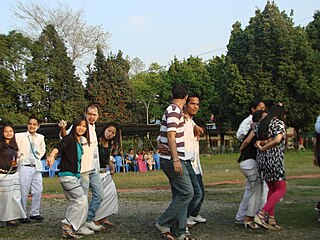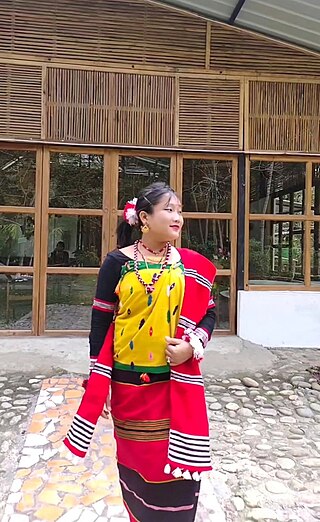Related Research Articles

Lhoba is any of a diverse amalgamation of Sino-Tibetan-speaking tribespeople living in and around Pemako, a region in southeastern Tibet including Mainling, Medog and Zayü counties of Nyingchi and Lhünzê County of Shannan, Tibet.

Nyishi community is the largest ethnic group in Arunachal Pradesh in north-eastern India. The Nyishi language belongs to the Sino-Tibetan family, however, the origin is disputed. Their population of around 300,000 makes them the most populous tribe of Arunachal Pradesh, closely followed by the tribes of the Adi according to 2001 census.

Donyi Polo is the designation given to the indigenous religion, of animistic and shamanic type, of the Tani and other Sino-Tibetan peoples of Arunachal Pradesh and Assam in Northeast India. The name "Donyi-Polo" means "Sun-Moon", and was chosen for the religion in the process of its revitalisation and institutionalisation started in the 1970s in response to inroads made by Christianity and the possibility of absorption into Hinduism.
Nature worship, also called naturism or physiolatry, is any of a variety of religious, spiritual and devotional practices that focus on the worship of the nature spirits considered to be behind the natural phenomena visible throughout nature. A nature deity can be in charge of nature, a place, a biotope, the biosphere, the cosmos, or the universe. Nature worship is often considered the primitive source of modern religious beliefs and can be found in pantheism, panentheism, deism, polytheism, animism, Taoism, totemism, Hinduism, shamanism, some theism and paganism including Wicca. Common to most forms of nature worship is a spiritual focus on the individual's connection and influence on some aspects of the natural world and reverence towards it. Due to their admiration of nature, the works of Edmund Spenser, Anthony Ashley-Cooper and Carl Linnaeus were viewed as nature worship.
Daporijo is a census town in the Upper Subansiri district, Indian state of Arunachal Pradesh in the Northeast of India.

In Northeastern India, the Miju Mishmi, also known as Kaman or Kammaan, are one of the three tribes of the Mishmi people of Tibet and Arunachal Pradesh. Members of this tribe are located in Anjaw and Lohit district. The Miju clans claim to have come from the Kachin country of Burma. They speak languages of the Midzu branch of Tibeto-Burman.
The Tutsa people, also known as the Tutsa Naga, are a Tibeto-Burmese ethnic group inhabiting the western parts of Changlang and Khimiyong circles and the eastern part of Tirap districts of the Northeast Indian state of Arunachal Pradesh. Ethnically, the Tutsa are closely related to the Tangsa and were classified as members of the Tangsa in all census records until 1981. As of 2001 their population stood at 25,000.

The Tagins are one of the major tribes of Arunachal Pradesh, India, a member of the larger designation of Tani Tribes. The Tagins refers to a tribe of Northeast India Region. The Tagins are members of the larger designation of Abotani. Most Tagin are adherents of Donyi-Polo, with a Christian minority.

The Tani people refer to the Adi, Apatani, Galo, Mising, Nyishi, and Tagin peoples. They are a part of the Sino-Tibetan ethnic group. Sharing common beliefs and ancestries, they speak various Tani languages and reside in the Indian states of Arunachal Pradesh and Assam, as well as the Tibet Autonomous Region in China.

Hill Miri are a native tribe of Arunachal Pradesh in Northeast India. They are spread in Upper Subansiri Kamle and adjoining districts. They speak a Tibeto-Burman language, but the exact origin of their language is disputed.
Murung is the Festival of Prosperity, celebrated by the Apatanis of Lower Subansiri district in Arunachal Pradesh, India. Though an individual festival, whole villages and indeed the whole of the Apatani people get involved in the festival. It is celebrated in the Month of January or Murung piilo. Besides it the Apatanis also celebrate Myoko in the month of march and the Dree Festival from 4 to 7 July every year.

The village deities of Southern India are the numerous spirits and other beings venerated as part of the Dravidian folk tradition in villages throughout South India. These deities, mainly goddesses, are intimately associated with the well-being of the village, and can have either benevolent or violent tendencies. These deities are presently in various stages of syncretism or assimilation with mainstream Hindu traditions.
Mara or Mra refers to a tribe in Arunachal Pradesh. The Mara (Mra) inhabit in Limeking in Upper Subansiri, just south of Taksing which is inhabited by the Nga. Like other Tagins, the Mara subscribe to the Donyi Polo faith but have come under considerable Tibetan Buddhist influence as a result of centuries of interactions with the Tibetans in the north.

The 'Mopin' or 'Moopin' Festival is an agricultural festival celebrated by the Galo tribe of Arunachal Pradesh, India in particular of the Galo group of tribes which resides in East Siang and West Siang districts. It is a celebration of the harvesting season held in the Galo months of "Lumi" and "Luki", corresponding to March–April and the new year for the Galo tribe. The Galo tribe follow an animist religion called Donyi-Polo.
Nyokum is a festival celebrated by the Nyishi tribe of the Indian state of Arunachal Pradesh. The Word Nyokum has been derived from the combination of two words - Nyok means land (earth) and Kum means collectiveness or togetherness. Therefore, the Nyokum festival may very well be interpreted as inviting all the Gods and Goddesses of the universe, with the Nyokum Goddess as the principal deity, to a particular venue at a particular time. The festival is commonly celebrated by the people from all class and walk of life for better productivity, prosperity and happiness of all human beings.

The Mising people are a Sino-Tibetan ethnic group inhabiting mostly in the Northeast Indian states of Assam and Arunachal Pradesh. They are part of the greater Tani group of people of India and Tibet Autonomous Region of China.
Here is a list of glossary of culture of India in alphabetical order:

Mo or Moism is the religion of most Zhuang people, the largest ethnic minority of China. It has a large presence in Guangxi. While it has a supreme god, the creator Bu Luotuo (布洛陀), numerous other deities are venerated as well. It has a three-element-theory. Mo is animistic, teaching that spirits are present in everything.
Marriage Practices of Galo Tribe or Traditional Galo Tribe Wedding/Marriage Practices are part of the cultural fabric of Arunachal Pradesh, India. In Galo dialect, it is called as NYIDA.

Circassian paganism, also called Khabzeism or Khabzism, is the ethnic religion of the Circassians. It is based on worshipping the supreme god Theshkhue (Тхьэшхуэ) and other minor deities under his rule, to each of whom is attributed an element, action or item of veneration and control. The religion also strongly focuses on the perfection of the soul, developing spiritual maturity and honour until a practitioner may enter the heavens, in union with their ancestors.
References
- 1 2 Pakba, Tagia (5 January 2017). "'Si-Donyi' – the festival of Arunachal Pradesh". The Arunachal Times. The Arunachal Times Publications Pvt. Ltd. Retrieved 20 July 2017.
- ↑ "'Si Donyi Festival: Tagin Tribe - Arunachal Pradesh". Greener Pastures. First Choice. Retrieved 20 July 2017.
- ↑ "Si-Donyi Festival to be Celebrated from January 4". Eclectic NorthEast. 15 December 2016. Retrieved 20 July 2017.
- ↑ "Si-Donyi Festival". India's North East. Rongjeng Technologies Pvt. Ltd. 10 April 2016. Retrieved 20 July 2017.
- ↑ "Si-Donyi Celebrated with Fervor in Arunachal". Northeast Today. 7 January 2016. Retrieved 20 July 2017.